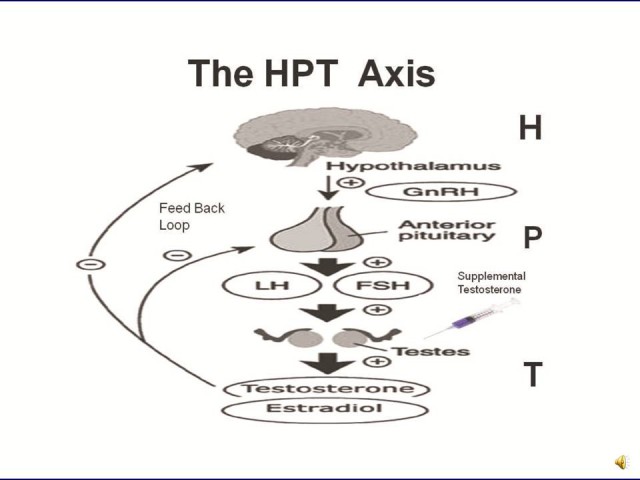Inhibition and Recovery of Natural Testosterone Production
October 11, 1999 By Bill Roberts Leave a Comment
One of the most significant side effects of anabolic/androgenic steroid (AAS) use is inhibition of natural testosterone production. There is no way to entirely avoid the problem, but there are ways to minimize the problem and recover natural testosterone levels reasonably quickly after a cycle. In this article, we will look at the problem of inhibition, its causes, and the best solutions currently known.
The Causes of Inhibition
Elevated hormone levels, in general,willcause inhibition of natural testosterone production. Many bodybuilders have come to believe that elevated estrogen levels alone are the sole cause of inhibition, and believe that by blocking estrogen, they can block inhibition.
This is not true. For example, consider the results seen in the second 2-on / 4-off cycle case study reported on MESO-Rx where Jim used 50 mg/day of trenbolone acetate, which does not aromatize, 50 mg/day of Dianabol, which does aromatize, with 250 mg/day of Cytadren as an aromatase inhibitor and 50 mg/day Clomid as an estrogen receptor blocker. His estrogen levels remained in the normal range, though elevated from baseline, since apparently the Cytadren was not sufficient to block aromatization completely. The Clomid should easily have been able to overcome normal estrogen levels, and so if the estrogen-only theory of inhibition were correct, Jim should have been suffering no inhibition. But the fact is, his testosterone levels dropped to only 1/10 his baseline value. Estrogen alone was not the cause of his inhibition. It could not have been the cause of any of it, given the normal levels and the Clomid use.
So much for the estrogen-only theory of inhibition that has been claimed by other writers. That isn’t to say, though, that estrogen is notalsoinhibitory: it is.
What then besides estrogen can cause inhibition? DHT, which does not aromatize, has been extensively shown to cause inhibition of testosterone production. Androgen alone, then, is sufficient to cause inhibition. In Jim’s case, androgen use was moderately heavy, and androgen alone would seem the cause of the inhibition.
Progesterone is another hormone that can cause inhibition, when used long-term. Paradoxically, in the short term it can be stimulatory. Other relevant factors include beta agonists, opiates, melatonin, prolactin, and probably other compounds. With the exception of beta agonists (e.g. ephedrine and Clenbuterol) and opiates (natural endorphins on the one hand being inhibitory, and Nubain blocking such inhibition) manipulation of these would not seem useful in bodybuilding.
October 11, 1999 By Bill Roberts Leave a Comment
One of the most significant side effects of anabolic/androgenic steroid (AAS) use is inhibition of natural testosterone production. There is no way to entirely avoid the problem, but there are ways to minimize the problem and recover natural testosterone levels reasonably quickly after a cycle. In this article, we will look at the problem of inhibition, its causes, and the best solutions currently known.
The Causes of Inhibition
Elevated hormone levels, in general,willcause inhibition of natural testosterone production. Many bodybuilders have come to believe that elevated estrogen levels alone are the sole cause of inhibition, and believe that by blocking estrogen, they can block inhibition.
This is not true. For example, consider the results seen in the second 2-on / 4-off cycle case study reported on MESO-Rx where Jim used 50 mg/day of trenbolone acetate, which does not aromatize, 50 mg/day of Dianabol, which does aromatize, with 250 mg/day of Cytadren as an aromatase inhibitor and 50 mg/day Clomid as an estrogen receptor blocker. His estrogen levels remained in the normal range, though elevated from baseline, since apparently the Cytadren was not sufficient to block aromatization completely. The Clomid should easily have been able to overcome normal estrogen levels, and so if the estrogen-only theory of inhibition were correct, Jim should have been suffering no inhibition. But the fact is, his testosterone levels dropped to only 1/10 his baseline value. Estrogen alone was not the cause of his inhibition. It could not have been the cause of any of it, given the normal levels and the Clomid use.
So much for the estrogen-only theory of inhibition that has been claimed by other writers. That isn’t to say, though, that estrogen is notalsoinhibitory: it is.
What then besides estrogen can cause inhibition? DHT, which does not aromatize, has been extensively shown to cause inhibition of testosterone production. Androgen alone, then, is sufficient to cause inhibition. In Jim’s case, androgen use was moderately heavy, and androgen alone would seem the cause of the inhibition.
Progesterone is another hormone that can cause inhibition, when used long-term. Paradoxically, in the short term it can be stimulatory. Other relevant factors include beta agonists, opiates, melatonin, prolactin, and probably other compounds. With the exception of beta agonists (e.g. ephedrine and Clenbuterol) and opiates (natural endorphins on the one hand being inhibitory, and Nubain blocking such inhibition) manipulation of these would not seem useful in bodybuilding.


Comment